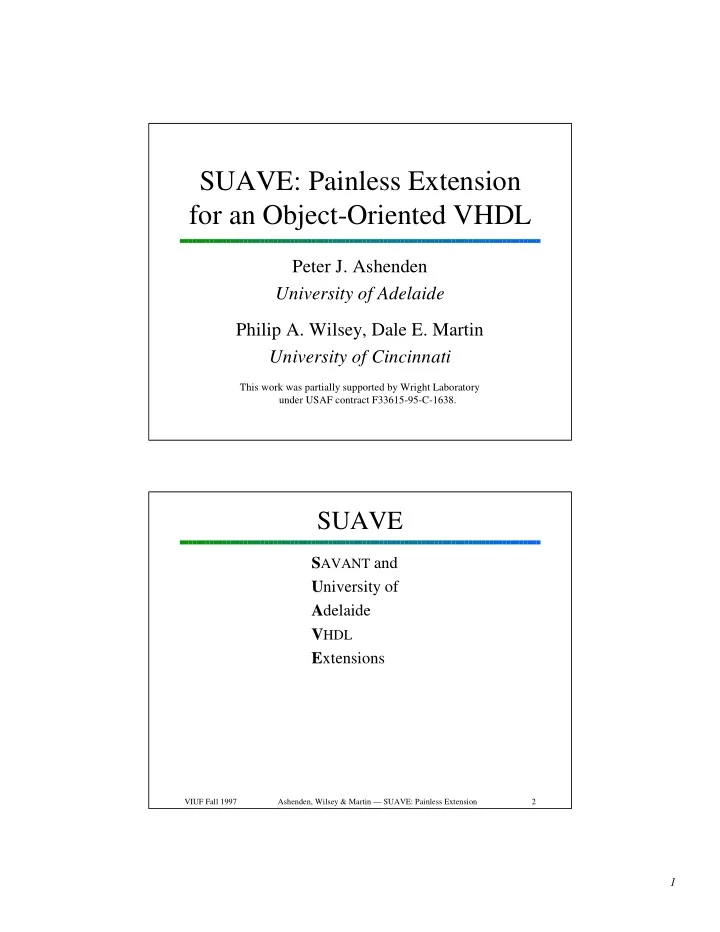

SUAVE: Painless Extension for an Object-Oriented VHDL Peter J. Ashenden University of Adelaide Philip A. Wilsey, Dale E. Martin University of Cincinnati This work was partially supported by Wright Laboratory under USAF contract F33615-95-C-1638. SUAVE S AVANT and S U niversity of U A delaide A V HDL V E xtensions E VIUF Fall 1997 Ashenden, Wilsey & Martin — SUAVE: Painless Extension 2 1
Outline • Design Objectives • Extension to the type system – type derivation & inheritance – type extension – abstract types – class-wide types • Extensions for encapsulation – private types and private parts • Integrating encapsulation and inheritance VIUF Fall 1997 Ashenden, Wilsey & Martin — SUAVE: Painless Extension 3 Design Objectives • Support high-level modeling – improve encapsulation and information hiding – provide for hierarchies of abstraction • Support re-use and incremental development – polymorphism, dynamic binding, type genericity • Preserve capability for synthesis & other analysis • Support hw/sw codesign – improved integration with programming languages . . . VIUF Fall 1997 Ashenden, Wilsey & Martin — SUAVE: Painless Extension 4 2
Design Objectives (cont) • Refinement through elaboration of components – avoid repartitioning • Preserve correctness of existing models • Design principles from VHDL-93 – preserve “conceptual integrity” VIUF Fall 1997 Ashenden, Wilsey & Martin — SUAVE: Painless Extension 5 Overview of Extensions • Borrow heavily from Ada-95 – VHDL already has much in common with Ada – borrow encapsulation, information hiding, inheritance, genericity features • Class-based cf programming by extension – class-based • replicates package features • choose one or the other, but not both! – programming by extension • integrates better with signal semantics VIUF Fall 1997 Ashenden, Wilsey & Martin — SUAVE: Painless Extension 6 3
Type Derivation and Classes • Adopt from Ada-95: – tagged records – type derivation • type derived from tagged record can add elements • inherits primitive operations from parent type • can override/augment operations – class-wide types, class-wide operations • T’Class is hierarchy of types derived from T • dynamic dispatching – abstract type and operations • Signals and dynamic variables can be class-wide VIUF Fall 1997 Ashenden, Wilsey & Martin — SUAVE: Painless Extension 7 Type Derivation Example type instruction is tagged record opcode : opcode_type; end record instruction; function privileged ( instr : instruction; mode : protection_mode ) return boolean; procedure disassemble ( instr : instruction; file output : text ); type ALU_instruction is new instruction with record destination, source_1, source_2 : register_number; end record ALU_instruction; procedure disassemble ( instr : ALU_instruction; file output : text ); VIUF Fall 1997 Ashenden, Wilsey & Martin — SUAVE: Painless Extension 8 4
Type Derivation Example (cont) type memory_instruction is abstract new instruction with record base : register_number; offset : integer; end record memory_instruction; function effective_address_of ( instr : memory_instruction ) return natural; procedure perform_memory_transfer ( instr : memory_instruction ) is abstract ; type load_instruction is new memory_instruction with record destination : reg_number; end record load_instruction; procedure perform_memory_transfer ( instr : load_instruction ); type store_instruction is new memory_instruction with record source : reg_number; end record store_instruction; procedure perform_memory_transfer ( instr : store_instruction ); VIUF Fall 1997 Ashenden, Wilsey & Martin — SUAVE: Painless Extension 9 Type Derivation Example (cont) procedure execute ( instr : instruction'class ) is begin disassemble ( instr, trace_file ); if privileged(instr) and execution_mode = user then handle_privilege_violation; else . . . end if ; end procedure execute; entity instruction_reg is port ( load_enable : in bit; instr_in : in instruction'class; instr_out : out instruction'class ); end entity instruction_reg; VIUF Fall 1997 Ashenden, Wilsey & Martin — SUAVE: Painless Extension 10 5
Encapsulation • Strengthen existing package feature – used to define secure ADTs • Package can have visible part and private part • Private type – declare partial view in visible part • includes some contractual details – declare full view in private part • Allow packages in any declarative region – local ADTs VIUF Fall 1997 Ashenden, Wilsey & Martin — SUAVE: Painless Extension 11 Encapsulation Example package complex_numbers is type complex is private ; constant i : complex; function cartesian_complex ( re, im : real ) return complex; function re ( C : complex ) return real; function im ( C : complex ) return real; function "abs" ( C : complex ) return real; function arg ( C : complex ) return real; function "+" ( L, R : complex ) return complex; function " – " ( L, R : complex ) return complex; . . . private type complex is record re, im : real; end record complex; end package complex_numbers; VIUF Fall 1997 Ashenden, Wilsey & Martin — SUAVE: Painless Extension 12 6
Encapsulation Example (cont) use complex_numbers. all ; signal a, b, sum : complex := cartesian_complex(0.0, 0.0); signal enable : bit; . . . sum <= a + b after 10 ns when enable = '1' else 0.0 + 0.0*i after 10 ns; VIUF Fall 1997 Ashenden, Wilsey & Martin — SUAVE: Painless Extension 13 Interaction: Encapsulation and Derivation • Adopt mechanisms from Ada-95 – tagged private type • can be extended without revealing details of parent – private extension • concrete details of extension hidden • See paper for example VIUF Fall 1997 Ashenden, Wilsey & Martin — SUAVE: Painless Extension 14 7
Conclusion • SUAVE improves VHDL’s support for modeling – across the spectrum • system-level down to gate level – improves encapsulation, inheritance, genericity – integrates cleanly with existing language • Full details in papers and TRs – http://www.ececs.uc.edu/~petera/suave.html • Implementation in progress VIUF Fall 1997 Ashenden, Wilsey & Martin — SUAVE: Painless Extension 15 8
Recommend
More recommend